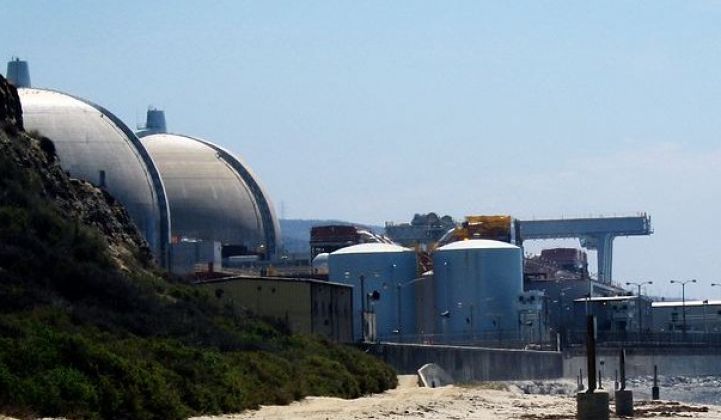Last year’s shuttering of the San Onofre Nuclear Generating Station (SONGS) along the southern California coast set off a pitched debate about the region’s near- and long-term energy future.
The plant, which is jointly owned by Southern California Edison (SCE) and San Diego Gas & Electric (SDG&E), was permanently closed in 2013 after the utilities decided it was too costly to repair leaking steam generators. Its closure represents a very real decision point for energy in California: will we continue with our business-as-usual, fossil-dependent approach to power or commit seriously to climate action and our new energy economy by replacing SONGS with clean energy?
It appears that if SDG&E gets its way, we’ll have more of the same.
Despite ample opportunities to replace the power from SONGS with renewables, energy efficiency, demand response and other pollution-free energy options, the San Diego utility is aiming to max out its procurement allowance with 600 megawatts of natural gas.
This is on top of the 300-megawatt natural gas-fired Pio Pico generator that was approved last year by the commission. Beyond its unnecessary cost to ratepayers, public health and climate, this plan for massive amounts of additional fossil generation is inconsistent with state regulation and is downright unjustified.
Back in March, the California Public Utilities Commission directed SCE and SDG&E to replace a small portion of the shuttered SONGS with clean options like solar and renewable energy, letting utilities decide how to fill the majority of the need. While the decision didn’t go nearly as far as it could have by actually requiring clean options, it did urge utilities to look first at “preferred” clean resources and allowed for competitive bidding between these clean resources and their conventional counterparts.
SDG&E apparently has no intention of even going that far. The utility is asking the commission to allow it to sign an exclusive multi-billion-dollar deal to purchase 600 megawatts of new gas generation -- the maximum amount allowed by the commission’s decision -- without allowing pollution-free sources to compete in an open bidding process.
Local advocates oppose the costly proposal, which Strela Cervas from the California Environmental Justice Alliance said “reflects the interests of the utility rather than the communities it serves.”
"This plan would have us rely on massive amounts of unnecessary and polluting natural gas power at a cost of billions of dollars without even considering cleaner options like energy efficiency, demand response and renewables," added Cervas.
In addition to disregarding the commission’s order for a competitive process, SDG&E’s plan for 600 megawatts of natural gas procurement does not account for recently approved transmission projects, which are expected to reduce local electricity needs by 800 to 1600 megawatts. SDG&E has done nothing to prove that there’s really a need for them to procure all that natural gas after California ratepayers have already covered the hefty cost of those transmission upgrades. Talk about a waste of customer dollars.
James Fine, Director of Energy Valuation Research and Senior Economist at Environmental Defense Fund, noted that “innovative solutions that empower customers to be partners in a reliable clean grid like energy efficiency, self-generation and demand response programs are likely to be lost if the Carlsbad gas-grab is approved.”
This rush for more natural gas would also have a big price tag for our climate. California has established a goal of reducing carbon and greenhouse gasses to 1990 levels by 2020, then to 80 percent below 1990 levels by 2050. The California Air Resources Board has already reported an increase in climate pollution from natural gas generation in the wake of the SONGS closure. Permanently replacing that carbon-free (albeit problematic) nuclear resource with more fossil power would put California even further behind in meeting its aggressive carbon reduction and clean energy targets.
That’s a loss on climate progress that California simply can’t afford.
The CPUC could make a decision on the proposal as early as this month. Advocates are urging state regulators to have the utility submit a new procurement plan that accurately reflects reductions in local area generation needs in order to confirm that new generating capacity is indeed necessary. From there, any remaining need should go through an all-source solicitation that is open to renewables and other clean resources rather than giving natural gas special treatment with a bilateral contract.
There is no reason to increase our dependence on the fossil fuels of the past when we can instead meet all of Southern California’s new energy needs reliably and affordably with clean options.
***
Jim Baak is Grid Integration Program Director at Vote Solar.



